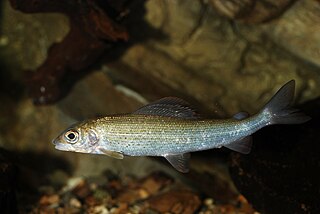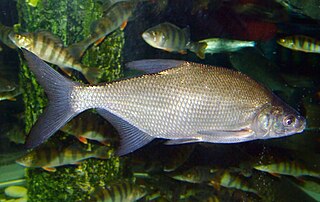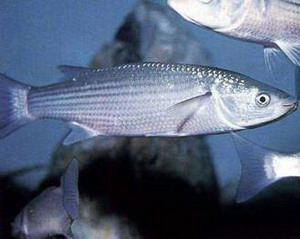
The Eurasian ruffe, also known as ruffe or pope, is a freshwater fish found in temperate regions of Europe and northern Asia. It has been introduced into the Great Lakes of North America, reportedly with unfortunate results, as it is invasive and is reproducing faster than other species. Its common names are ambiguous – "ruffe" may refer to any local member of its genus Gymnocephalus, which as a whole is native to Eurasia.

Thymallus thymallus, the grayling or European grayling, is a species of freshwater fish in the salmon family Salmonidae. It is the only species of the genus Thymallus native to Europe, where it is widespread from the United Kingdom and France to the Ural Mountains in Russia, and Balkans on the south-east, but does not occur in the southern parts of the continent. It was introduced to Morocco in 1948, but it does not appear to have become established there.

The common dace is a species of freshwater and brackish water ray-finned fish from the family Cyprinidae which is native to Europe but which has been introduced to other parts of the world. It is a quarry species for coarse anglers.

The zander, sander or pikeperch, is a species of ray-finned fish from the family Percidae, which also includes perch, ruffe and darter. It is found in freshwater and brackish habitats in western Eurasia. It is a popular game fish and has been introduced to a variety of localities outside its native range. It is the type species of the genus Sander.

Sea trout is the common name usually applied to anadromous (sea-run) forms of brown trout, and is often referred to as Salmo trutta morpha trutta. Other names for anadromous brown trout are bull trout, sewin (Wales), peel or peal, mort, finnock (Scotland), white trout (Ireland), Dollaghan (Northern Ireland and salmon trout.

Salmo trutta fario, sometimes called the river trout, and also known by the name of its parent species, the brown trout, is a predatory fish of the family Salmonidae and a subspecies or morph of the brown trout species, Salmo trutta, which also includes sea trout and a lacustrine trout. Depending on the supply of food, river trout measure 20 to 80 cm (0.7–2.6 ft) in length; exceptionally they may be up to 1 m (3.3 ft) long and weigh up to over 13 kg (29 lb). Their back is olive-dark brown and silvery blue, red spots with light edges occur towards the belly, the belly itself is whitish yellow. River trout usually attain a weight of up to 2 kg (4.4 lb). They can live for up to 18 years.

The common bream, freshwater bream, bream, bronze bream, carp bream or sweaty bream, is a European species of freshwater fish in the family Cyprinidae. It is now considered to be the only species in the genus Abramis.

Arctic cisco, also known as omul Russian: Омуль, is an anadromous species of freshwater whitefish that inhabits the Arctic parts of Siberia, Alaska and Canada. It has a close freshwater relative in several lakes of Ireland, known as the pollan, alternatively regarded as conspecific with it, or as a distinct species.

The flathead grey mullet is an important food fish species in the mullet family Mugilidae. It is found in coastal tropical and subtropical waters worldwide. Its length is typically 30 to 75 centimetres. It is known with numerous English names, including the flathead mullet, striped mullet, black mullet, bully mullet, common mullet, grey mullet, sea mullet and mullet, among others.

The sterlet is a relatively small species of sturgeon from Eurasia native to large rivers that flow into the Black Sea, Azov Sea, and Caspian Sea, as well as rivers in Siberia as far east as Yenisei. Populations migrating between fresh and salt water (anadromous) have been extirpated.Also known as Sterlet sturgeon.

The allis shad is a widespread Northeast Atlantic species of fish in the herring family, Clupeidae. It is an anadromous fish which migrates into fresh water to spawn. It is found in the eastern Atlantic Ocean, the western Baltic Sea and the western Mediterranean Sea. In appearance it resembles an Atlantic herring but has a distinctive dark spot behind the gill cover and sometimes a row of up to six spots behind this. It sometimes hybridises with the twait shad. This fish becomes mature when three or more years old and migrates to estuaries, later swimming up rivers to spawn. Populations of this fish have declined due to overfishing, pollution and habitat destruction. Conservation of this species is covered by Appendix III of the Bern Convention and Appendix II and V of the European Community Habitats Directive.

Gymnocephalus is a genus of ray-finned fishes from the family Percidae, which includes the perches, pike-perches and darters. They are from the Western Palearctic area, although one species, Gymnocephalus cernua has been accidentally introduced to the Great Lakes region where it is regarded as an invasive species. They have the common name "ruffe" and resemble the true perches in the genus Perca, but are usually smaller and have a different pattern.

Balon's ruffe, also known as the Danube ruffe, is a species of freshwater ray-finned fish, a ruffe, from the family Percidae which is native to the drainages of the Danube from delta to Germany and the Dnieper from delta to Kyiv and is expected to occur in the Dniester. It inhabits areas with sand or mud substrates. It is active at night and feeds on small invertebrates. This species can reach a length of 15 centimetres (5.9 in) SL. It is named after Polish-Canadian ichthyologist Eugene K. Balon (1930-2013).

The schraetzer or striped ruffe, is a species of perch native to the Danube basin. It is a schooling fish, being found over muddy or sandy bottoms of moderately flowing large rivers. This species can reach a length of 30 centimetres (12 in) TL though most only grow to 15 centimetres (5.9 in). The greatest recorded weight for this species is 250 grams (8.8 oz). While of no interest to commercial fisheries, it is popular as a game fish and is also frequently used as bait in pursuit of other species.

Pseudoscaphirhynchus is a genus of relatively small, highly threatened sturgeons that are restricted to the Aral Sea system, including the Amu Darya and Syr Darya river basins, in Central Asia.
Stenodus nelma, known alternatively as the nelma, sheefish, siifish, inconnu or connie, is a commercial species of freshwater whitefish in the family Salmonidae. It is widespread in the Arctic rivers from the Kola Peninsula eastward across Siberia to the Anadyr River and also in the North American basins of the Yukon River and Mackenzie River.

Coregonus maraena, referred to in English as the maraene, maraena whitefish or the whitefish, is a whitefish of the family Salmonidae that occurs in the Baltic Sea basin - in the sea itself and the inflowing rivers, and in several lakes as landlocked populations. It is found in Denmark, Estonia, Finland, Germany, Latvia, Lithuania, Netherlands, Norway, Poland, Slovakia, Russia and Sweden. As of 2013, it has been listed as a vulnerable species by the IUCN and as endangered by HELCOM. It is an extremely important fish within the Baltic Sea ecosystem, both for population equilibrium and for the local diets of the surrounding human population. Due to a variety of factors, mostly overfishing, the maraena’s population dwindled to near-extinction levels. Thus, rampant repopulation was enacted to preserve this important fish.

The thinlip mullet is a species of fish in the family Mugilidae. It is found in shallow European waters and is a migratory species.
Gymnocephalus ambriaelacus is a species of freshwater ray-finned fish, a ruffe, from the family Percidae which is endemic to Lake Ammersee, in the upper Danube basin in southern Germany. This species can reach a length is 11.7 centimetres (4.6 in) (SL). The species is classified as Critically Endangered as its population is declining following the introduction of the ruffe. Some authorities suggest that this taxon may be synonymous with the Balon's ruffe.

The white sucker is a species of freshwater cypriniform fish inhabiting the upper Midwest and Northeast in North America, but it is also found as far south as Georgia and as far west as New Mexico. The fish is commonly known as a "sucker" due to its fleshy, papillose lips that suck up organic matter and aufwuchs from the bottom of rivers and streams.



















